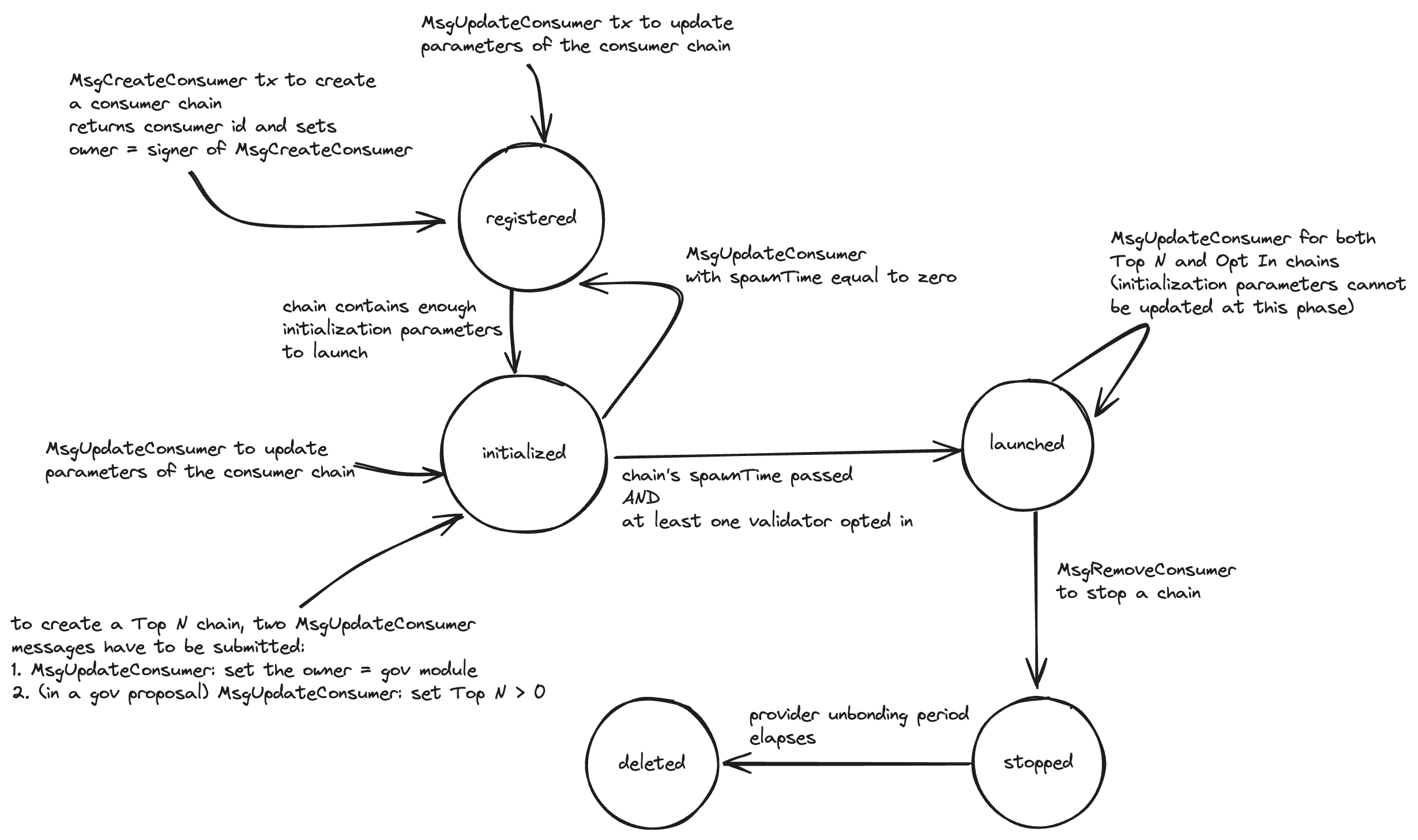Permissionless ICS
With the advent of Permissionless ICS, Opt In consumer chains can launch without going through governance. However, Top N chains can only be launched through governance as a Top N chain requires the top N% of the provider validators to validate the chain. In what follows, we explain the phases of a consumer chain and how we can launch a chain under Permissionless ICS.
If you are preparing a new consumer chain you can find more information in the consumer onboarding checklist.
From chainId to consumerId
With Permissionless ICS, anyone can issue a transaction to launch a consumer chain. As a result, the chainId of a consumer
chain cannot uniquely identify a consumer chain from the point of view of the provider, because we could have multiple
consumer chains with the exact same chainId.
Because of this, Permissionless ICS introduces the notion of a consumerId. The provider associates for each consumer chain
a unique consumerId. A consumer chain can then interact (e.g., update chain parameters) with its chain by utilizing this consumerId.
Additionally, validators can interact (e.g., assign a consumer key, opt in, etc.) with a consumer chain by using the consumer's consumerId.
Phases of a Consumer Chain
A consumer chain can reside in one of the phases shown in the table below.
| Phase | Description |
|---|---|
| Registered | The consumer chain was created with MsgCreateConsumer and has received the consumer's associated consumerId. The chain cannot launch yet. |
| Initialized | The consumer chain has set all the initialization parameters and is ready to launch at spawnTime. |
| Launched | The consumer chain has launched and is running. The provider chain is sending VSCPackets to the consumer. |
| Stopped | The consumer chain is stopped and the provider chain is not sending VSCPackets to the consumer. The consumer chain is slated to be deleted. |
| Deleted | The majority of the state of the consumer chain on the provider is deleted. Basic metadata of the consumer chain, such as the chainId, etc. are not deleted. |
The following diagram shows the phases and the actions that need to take place to move from one phase to another.

Owner of a Consumer Chain
A consumer chain (either Opt In or Top N) has an owner.
An Opt In chain is owned by the address that initially sent and signed the MsgCreateConsumer message.
A Top N chain is owned by the governance module and can only be updated through governance proposals.
Note that the owner of a chain can be changed at any later point in time by providing a new_owner_address message
in the MsgUpdateConsumer message. As a result, an Opt In chain can change its owner to be the governance module
in order to transform to Top N chain, and a Top N chain can change its owner to something that is not the governance
module to become an Opt In chain (see below).
Launch an Opt In Chain
To launch an Opt In chain, we have to send a MsgCreateConsumer message. This message returns the newly created consumerId
associated with this consumer. The chain is considered to be in the registered phase at this point and its owner is the one
that signed the MsgCreateConsumer message.
If the optional initialization_parameters are provided in the MsgCreateConsumer, then the chain is considered to be in the
initialized phase and the chain can launch at the spawnTime provided in the initialization_parameters.
If no initialization_parameters are provided in MsgCreateConsumer, the consumer can later set those parameters
by issuing a MsgUpdateConsumer. The chain would then move to the initialized phase and be slated to launch.
An Opt In can only launch at spawnTime if at least one validator is opted in at spawnTime.
Launch a Top N Chain
To launch a Top N chain, we need to issue a MsgCreateConsumer to retrieve the consumerId. At this stage, the chain
corresponds to an Opt In chain and the owner of the chain is the one that signed the MsgCreateConsumer.
For the chain to become Top N we need to issue a message and a governance proposal:
- A
MsgUpdateConsumermessage to change the owner of the chain to be that of the governance module, that is tocosmos10d07y265gmmuvt4z0w9aw880jnsr700j6zn9kn. - A governance proposal that includes a
MsgUpdateConsumerthat sets theTopNof the consumer chain.
If top_N, validators_power_cap, or some other argument is not included in the power-shaping parameters, then it is considered
that the default value is set for this argument. For example, if a Top 50% chain wants to only modify validators_power_cap
from 35 to 40, then the power-shaping parameters in MsgUpdateConsumer still need to include that top_N is 50. Otherwise
top_N would be set to its default value of 0, and the chain would become an Opt-In chain.
To be safe, if you include power-shaping parameters in the MsgUpdateConsumer, always include top_N and all the power-shaping parameters.
The same applies for the initialization parameters.
Transform an Opt In Chain to Top N and Vice Versa
From Opt In to Top N
This corresponds to the case of launching a Top N chain. The Opt In chain
has to issue a MsgUpdateConsumer to change the owner of the consumer to be that of the governance module and
to issue a governance proposal that includes a MsgUpdateConsumer and sets the TopN of the consumer chain.
From Top N to Opt In
A consumer chain can move from Top N to Opt In by issuing a governance proposal that includes a MsgUpdateConsumer
that sets TopN to 0 and also sets the owner of the chain to not be the governance module anymore.